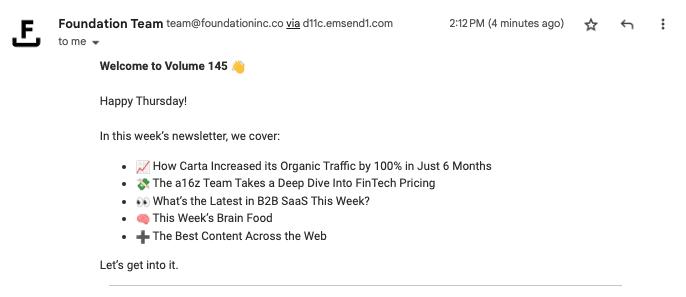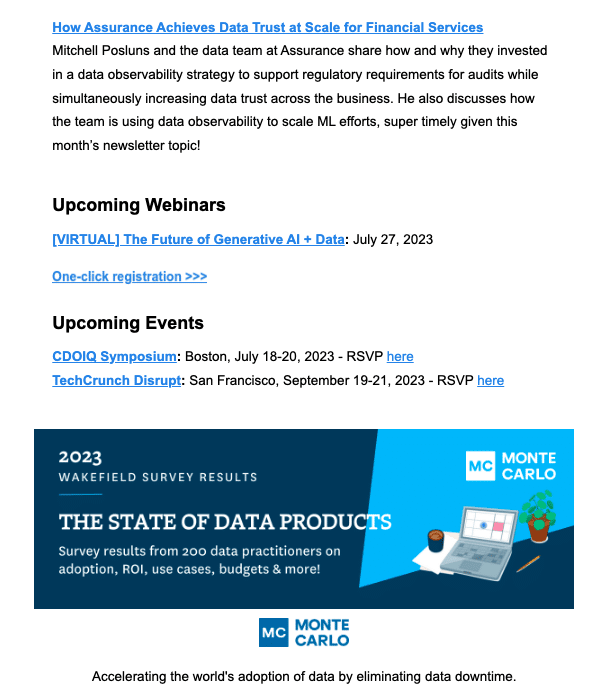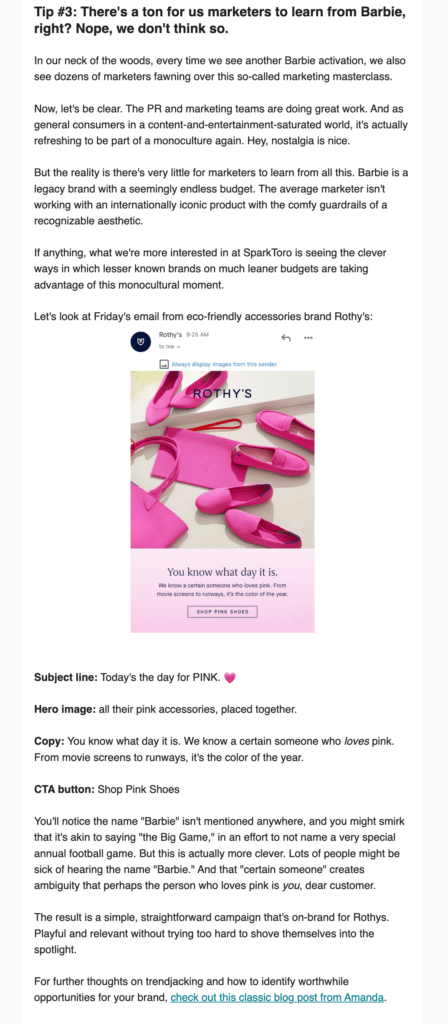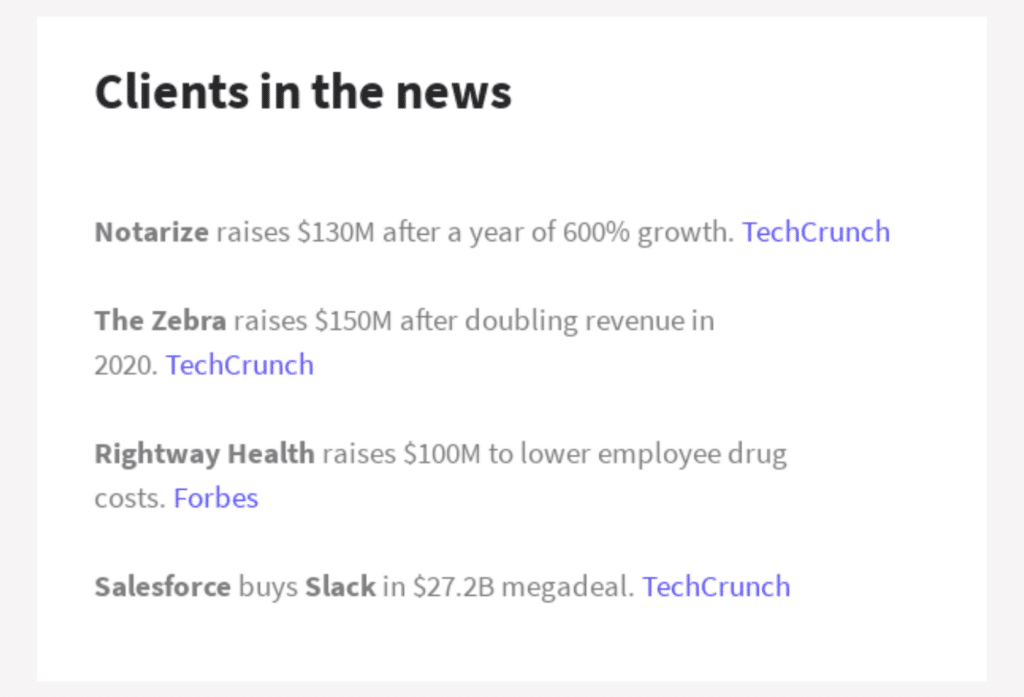We B2B marketers are notorious for hopping on the latest bandwagon (hello Threads, so long Clubhouse). But we also know how to hold onto a solid channel when we find it — like email marketing. Specifically, good old-fashioned newsletters.
According to the Content Marketing Institute, as of 2023, nearly seven out of ten B2B marketers rely on newsletters to distribute their content.
That said, we don’t always make time to give our trusty workhorses the attention they deserve — and it’s a short leap from tried-and-true to tired-and-boring.
So we’ve compiled ten ideas for how to liven up your email content marketing newsletter. (Spoiler alert: making a listicle is not one of them.)
Add a table of contents
Especially if you like to include a decent amount of content in your email marketing newsletter, this is a no-brainer. Adding a table of contents at the top of your newsletter lets your readers know what you’re covering “below the fold”, which helps them find their way to articles or links that might otherwise be buried or easily missed.
As a bonus, using a table of contents keeps you accountable for presenting an array of engaging, relevant content within your email. Writing that summary can be a helpful hint if your newsletter is getting stale — or if it’s a totally random mishmash of unrelated topics. (Not that we’ve ever seen B2B emails running into those issues…)
Here’s how marketing agency Foundation handles their table of contents: bullet points and emoji:

Mix up your content types and customer journey steps
Sometimes the hardest part of putting together a B2B newsletter is figuring out which articles or links to include from your vast library of content. (Or maybe we’re just projecting.) Developing a “recipe” can help make that process less daunting.
Here at Act-On, our demand gen manager Kelsey Yen sends email marketing newsletters with the explicit goal of moving prospects along the marketing funnel. So she layers a few different tactics within each email to bring this to life:
- Using a mix of content types, such as two blogs, one ebook, and one webinar per newsletter
- Offering content within each stage of the buyer’s journey, so there’s something for everyone
- Considering content priorities — what’s new, what needs to be promoted, and what’s seasonally relevant
This framework — mixing a certain number of content types and customer journey stages — automatically narrows down the content selection process. Three cheers for self-imposed constraints.
Kelsey also has a pro tip for her fellow demand gen marketers: select your content with lead scoring in mind. She hand-picks different pieces of content that will reveal the recipient’s purchase intent, such as a buying guide or demo message, to help move warmer leads closer to their SQL threshold.
Recommend curated content

Especially if you don’t have an extensive content library, curating third-party articles and videos is an easy way to beef up your content marketing newsletter.
No-code website builder Webflow handles their curation by including a “Cool things” section with links to external articles their primary audience — designers, creatives, and marketers — are likely to find interesting.
In the example on the right, they even manage to highlight their partner Flow Ninja by linking to their Twitter thread on generating inbound leads.
Answer a question of the week/month/etc.
Partner up with your customer success or sales team for this simple, three-step process. (In other words, delegate! Less content creation for you!)
- Step 1: Regularly source a question that real customers or bottom-of-funnel prospects ask about the problem you solve.
- Step 2: Come up with a concise, engaging answer (or an abbreviated version, and a link to the rest on your website).
- Step 3: Add this as a regularly rotating feature in your email marketing newsletter (weekly, monthly, etc.).
Bonus step: Invite readers to submit their own questions, because delegating content creation to your readers is a next-level marketing move.
Share the “best of” your industry
If you send your email newsletter frequently, this might be a way to spruce up your content rotation. Once a month, pick something related to your business and make a roundup of the best examples you’ve come across. (Or, if you don’t want to devote a whole newsletter to this concept, add a “best of the week” section to your regular edition.)
Here’s how the email marketing agency AlchemyWorx does it. They select six of the best emails from last month, add some commentary, and then publish the round-up as a blog post.
And don’t forget to notify everyone who made your best-of list. Often, they’ll share it with their audiences, or sign up for future editions.
Advertise your top-tier content
Keep one spot in your marketing newsletter set aside to “advertise” your highest-priority content, usually at the bottom or midpoint of your email.

If you have a designed template, treat this placement like a banner ad. If you use a text-only approach, think of it as an important sponsored link. Only in this case, the content you’re advertising is your own.
It’s the perfect way to regularly promote the latest ebook, research report, whitepaper, or webinar you invested significant dollars into. Or, look at your engagement reports to identify a blog post that isn’t seeing a ton of traffic but has great engagement or conversion rates. That’s a valuable asset you want to get more eyeballs on, so give it prime placement in your newsletter.
In the example to the right, data observability platform Monte Carlo uses their email “banner ad” to promote their original “State of Data Products” research report.
Include quizzes, polls, and surveys
We all like to share our opinions and see how we compare to others. That’s why quizzes, polls, and surveys tend to get great engagement. (They’re especially effective if you don’t show the results until someone has participated.) Include the poll directly in your email, or consider linking out to a LinkedIn poll for some multi-channel marketing action.
Just don’t make the polls too self-serving, or always business-focused. They’re supposed to be entertainment for your readers, so keep things light.
Try trendjacking (with caution)

Know how every brand sends out emails that reference the “Big Game” the week before that one Sunday in February? That’s trendjacking — hopping on the latest monoculture moment to drive engagement with your brand’s quasi-related content.
It works, if you do it right. But it’s really easy to do it wrong.
We like the trendjacking matrix Amanda Natividad lays out on the Sparktoro blog: zeroing in on the moments that align with your company’s core value proposition, or on the opportunities where you can move faster or go deeper than anyone else. That’s when you catch your audience’s attention in a meaningful way — rather than making them cringe.
For a very meta example, check out the excerpt from SparkToro’s audience research newsletter. Right at the moment when everyone was talking about Barbie, SparkToro chose to highlight how everyone was talking about Barbie — and link back to the article we just recommended on trendjacking.
Trendjacking a massive pop culture moment in order to talk about trendjacking? Now that’s playing three-dimensional chess.
Highlight customer stories at every possible moment

While your content marketing newsletter shouldn’t be overly promotional of your product, it is a great opportunity to highlight the amazing customers you work with. Case studies and customer profiles are just one way to subtly convey how many smart and successful brands choose to work with you.
For example, product design agency MetaLab has a simple “Clients in the news” section within their newsletter to name-drop impressive brands and fundraising numbers. MetaLab’s contributions to these companies isn’t the point — but by celebrating their clients’ latest wins, they create a strong association between their own brand and massive success.
Promote (a little) company news
This item comes last for a reason: it’s way too easy to over-index on product releases and award announcements. And the majority of your audience, frankly, isn’t going to care all that much.
For instance, our lifecycle marketing manager Jennifer Blanco uses the Act-On customer newsletter to share important product updates — but only if the release is relevant to all customers, rather than a niche feature that only a small subset of our audience will care about. And while events like webinars and educational power-ups have their own dedicated invitation sequences, Jennifer also uses the newsletter to cross-promote any events relevant to the majority of our recipients.
Jennifer and Kelsey both recommend treating company updates as a small part of your newsletter content mix. In fact, Kelsey estimates only 10-20% of the content in her marketing emails are actually promotional for the Act-On platform.
Remember, newsletters are educational resources, not advertisements for your product.
Looking for more B2B email marketing inspo? Learn how you can use AI as an email brainstorming partner or check out our recent webinar on getting your email marketing mojo back. It’s full of practical ideas from real-life marketers who are reinvigorating their pipeline through email.
